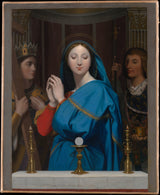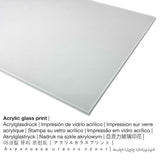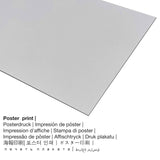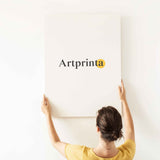Jean Auguste Dominique Ingres, 1852 - The Virgin Adoring the Host - fine art print
Tax included. Shipping calculated at checkout.
The art product
This modern art painting was created by Jean Auguste Dominique Ingres in 1852. The original was made with the size: 15 7/8 x 12 7/8 in (40,3 x 32,7 cm). Oil on canvas was used by the European artist as the medium of the work of art. What is more, this work of art is included in the art collection of The Metropolitan Museum of Art in New York City, New York, United States of America. With courtesy of - The Metropolitan Museum of Art, New York, Gift of Lila and Herman Shickman, 2005 (license: public domain). Also, the artwork has the following creditline: Gift of Lila and Herman Shickman, 2005. What is more, the alignment is in portrait format with a side ratio of 1 : 1.2, which implies that the length is 20% shorter than the width.
Which would be your preferred product material?
The product dropdown menu ofers you the opportunity to pick your individual size and material. You can choose your your favorite size and material among the following options:
- Printed poster (canvas material): The poster print is a printed cotton canvas paper with a slight structure on the surface. A poster print is best qualified for placing the fine art print with a custom-made frame. Please note, that depending on the absolute size of the poster we add a white margin of something between 2 - 6cm around the print motif, which facilitates the framing with your custom frame.
- Aluminium dibond (metal print): An Aluminium Dibond print is a print with a true depth effect. A non-reflective surface structure creates a fashionable look. The bright sections of the original artpiece shimmer with a silky gloss, however without any glare. The colors of the print are luminous in the highest definition, the fine details appear clear and crisp, and you can feel a matte appearance of the product. This direct print on Aluminum Dibond is the most popular entry-level product and is a truly stylish way to showcase fine art reproductions, as it puts all of the viewer’s attention on the replica of the artwork.
- The acrylic glass print: The print on acrylic glass, which is sometimes described as a print on plexiglass, will change your favorite original work of art into stunning décor. Your own version of the work of art is being manufactured with the help of modern UV printing technology. It makes vibrant and stunning colors. With an acrylic glass fine art print contrasts plus smaller details will be more visible with the help of the delicate gradation in the picture. The acrylic glass protects your chosen art replica against light and external influences for many years.
- Canvas print: The printed canvas material applied on a wood stretcher frame. A canvas creates the unique look of three-dimensionality. A printed canvas produces a cosy and comfy atmosphere. Canvas prints are relatively low in weight, meaning that it is easy and straightforward to hang up your Canvas print without additional wall-mounts. A canvas print is suited for any type of wall.
Legal disclaimer: We strive to depict our art products as accurate as possible and to display them visually in our shop. Although, the tone of the print materials, as well as the imprint can vary to a certain extent from the image on the device's monitor. Depending on the screen settings and the quality of the surface, not all color pigments are printed as realisitcally as the digital version shown here. Given that the fine art prints are processed and printed by hand, there might as well be slight discrepancies in the motif's exact position and the size.
Structured item information
| Product categorization: | fine art print |
| Method of reproduction: | digital reproduction |
| Manufacturing process: | UV direct printing |
| Provenance: | made in Germany |
| Type of stock: | production on demand |
| Intended usage: | art collection (reproductions), wall decoration |
| Orientation: | portrait format |
| Image ratio: | 1 : 1.2 |
| Image ratio interpretation: | the length is 20% shorter than the width |
| Fabric options: | acrylic glass print (with real glass coating), canvas print, metal print (aluminium dibond), poster print (canvas paper) |
| Canvas print (canvas on stretcher frame): | 50x60cm - 20x24", 100x120cm - 39x47", 150x180cm - 59x71" |
| Acrylic glass print (with real glass coating) size variants: | 50x60cm - 20x24", 100x120cm - 39x47", 150x180cm - 59x71" |
| Poster print (canvas paper): | 50x60cm - 20x24", 100x120cm - 39x47" |
| Dibond print (alumnium material) sizes: | 50x60cm - 20x24", 100x120cm - 39x47" |
| Framing of the artprint: | without frame |
Work of art table
| Title of the work of art: | "The Virgin Adoring the Host" |
| Classification of the artwork: | painting |
| General category: | modern art |
| Artwork century: | 19th century |
| Created in the year: | 1852 |
| Artwork age: | over 160 years old |
| Medium of original artwork: | oil on canvas |
| Dimensions of the original work of art: | 15 7/8 x 12 7/8 in (40,3 x 32,7 cm) |
| Museum / collection: | The Metropolitan Museum of Art |
| Museum location: | New York City, New York, United States of America |
| Web URL: | The Metropolitan Museum of Art |
| License: | public domain |
| Courtesy of: | The Metropolitan Museum of Art, New York, Gift of Lila and Herman Shickman, 2005 |
| Creditline of artwork: | Gift of Lila and Herman Shickman, 2005 |
Artist details
| Artist: | Jean Auguste Dominique Ingres |
| Gender of the artist: | male |
| Nationality of artist: | French |
| Jobs: | painter |
| Country: | France |
| Classification: | modern artist |
| Age at death: | 87 years |
| Born: | 1780 |
| City of birth: | Montauban |
| Died in the year: | 1867 |
| Died in (place): | Paris |
Copyright © - Artprinta.com (Artprinta)
Artwork information from The Metropolitan Museum of Art website (© - by The Metropolitan Museum of Art - The Metropolitan Museum of Art)
This small, jewel-like devotional painting was made as a gift for Ingres’s friend Louise Marcotte, who introduced the artist to Delphine Ramel, whom he married in 1852. The Raphaelesque composition is based on one Ingres first painted in 1841 for the future czar Alexander II, which includes the two patron saints of Russia, Alexander Nevsky and Nicholas (Pushkin Museum of Fine Arts, Moscow). For this version, Ingres replaced the Russian saints with two French ones. He would go on to paint four more variants, as well as, in 1855, a watercolor for Madame Ingres herself (Fogg Museum, Cambridge, Mass.).














